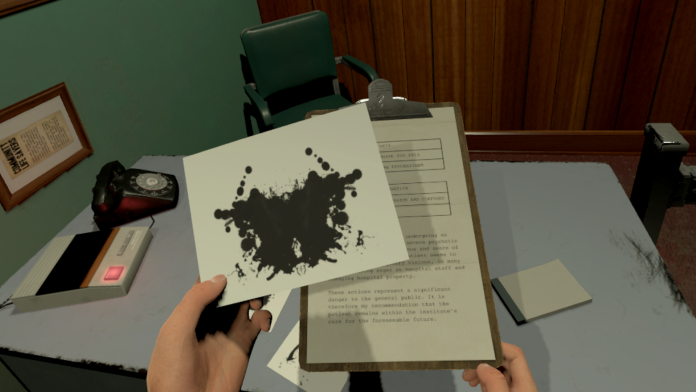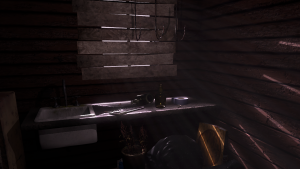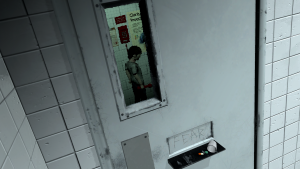Late last week indie developer Wolf & Wood revealed that it was bringing its popular virtual reality (VR) horror series, Chair in a Room, to the HTC Vive head-mounted display (HMD) in A Chair in a Room: Greenwater. The experience is evolving from the simple demo seen on the Oculus Rift and Google Cardboard into a full blown videogame using the user-tracked features of the kit it’s appearing on. VRFocus already went hands-on with the title, intrigued by what it had to say for Room Scale horror.
Now though, the full interview with creator Ryan Bousfield can be found below. In it, Bousfield talks about the extension of the Chair in a Room series to the HTC Vive, and the decision to make this latest entry a full VR videogame. He also discusses the challenges associated with Room Scale horror and scaring players too much. For the latest on A Chair in A Room: Greenwater, check back with VRFocus.
VRFocus: What is Chair in a Room and, more specifically, what are you announcing today?
Ryan Bousfield (RB): So Chair in a Room started as an Oculus Share project. So it was literally about 12 days’ work, more of a tech demo; an idea of what a horror experience could be in VR. So I kind of just did it over a few weekends and a break over 2014, and put it out there and went to a few meetups the response was absolutely amazing. It got much more interest and much more exposure than I could ever have imagined. It got picked up by a few sites.
And it’s kind of grown from there. I released the Android version in 2014. Again, it was just a simple, small story. I put that out there and it went absolutely, massively wild. It’s got over quarter of a million downloads on that now and the number one spot in the first 18 months of Google Cardboard, so that’s been absolutely brilliant.
And then for the last nine months I’ve been working on a full narrative which is six chapters which span different times. That starts in a hospital where you’re not sure who you are, why you’re there, or what you did to be there. Obviously there’s doctors and people around you feeding you medication and keeping you in there. So the story starts out from where you go back to your cell, you realise you have a lot of items and a lot of objects which you use to trigger memories which are actual memories of the events surrounding those objects.
So it’s sort of piecing together the different parts to build up that story and go back to those environments and back through those memories to work out why you’re there and why you would be locked away.
VRFocus: At what point did you look at the Vive and decide that was the platform you wanted to work with?
RB: So I’d worked with Cardboard and Oculus and looked at all the options at the time but I think it was just after GDC 2015 when I played a demo at Bossa Studios. It was TheBlu, a brilliant demo. It was a few minutes; see the whale, and it just kind of changed things. Being able to actually move around and be involved in this experience, to see things reacting to your interaction with the world, that really brought it about. And then the idea of just being able to do anything with it, the limitless possibilities.
VRFocus: Why did you decide to keep this new project as Chair in a Room instead of something new?
RB: I kept it as Chair in a Room simply because I’m a one-person studio at the moment so to market and push things further will be quite difficult a limited budget, so I’m using the interest of what’s already been. So the story and the Room Scale, although it does have chairs and rooms in there, it’s not necessarily the same narrative it was in the original.
VRFocus: How do you deal with threat in Room Scale horror? You know that nothing is going to grab you and throw you in that tracked area.
RB: Yeah, I’ve found a few things. Like, if you leave the threat next to a person for too long, they overcome that fear and then they just start to play about with it. So it’s not very scary at that point. So it’s keeping things out of the way, it’s putting things that are obscured through maybe windows, certainly reducing the amount of light or the visibility of the threat makes it a lot scarier.
I’ve found one of the more interesting things is when you overcome that threat. So you may be afraid of spiders or a spooky thing over in a corner. Now, you could just ignore that; take the headset off or wait there and nothing would happen, but you’ve got to try and drive the person to look over the edge just a little bit or look through the window and see that thing. And a lot of people will just carefully move in and gradually get closer and closer and then, over time they will look in there. And that’s when you’ll have a jump scare or you’ll trigger something.
VRFocus: On the other hand, then, what are your reservations about scaring people too much?
RB: Yeah, I think scaring people, especially with jump scares, in VR is pretty dangerous. I think overall with the design it’s got to be satisfying as the build-up, the tension with the audio, with the story, everything needs to be there. And then, every now and again, just drop something in there that relieves that tension a little bit, maybe gives you a little bit of a jump. But, overall, in the game itself, there’s only really– without putting the spoilers in there – there’s only a handful of jump scares.
Because there are points where the horror kind of encroaches on your space. And as long as you keep that to a small amount and keep the exposure to that down, then you can still create that excitement and that jump but without completely destroying a person or bringing them to tears. Everyone’s got a different level or a different limit of what they will and won’t accept. Through testing I’ve seen people pretty much cower down and go into a corner, or some people just power through and just take on whatever’s coming at them.
So it’s a quite different response for getting a balance and satisfying the people who want that experience and keep the people who are a lot more involved. They have to have an interest to carry on. I think the horror is a mixture of the music, the build-up, the tension, the symbolism. So there’s kind of psychological elements where you’re not sure who to trust and who not to trust, why you’re doing certain things. Do you have to tick every box and do everything you’re told in the game or do you go against it?
VRFocus: Being this is a psychological horror, you must have tried a lot of things that do and don’t work in VR?
RB: Yeah, so something you think would but doesn’t always work? Drawing people’s attention to events. So you need to bring people to the next moment, the next key thing. For example, in one of the earlier chapters which I’ve tightened up now; in a horror film, you hear dripping water, you’re not sure what it is, where does it lead to? The protagonist always stops, listens, then runs in. But, in a game, people here dripping water, they look over, they see something dripping from the ceiling, pointing down to a clue and, at that point, they just ignore it. They just think you have a leak.
So you definitely have to put more than one clue in to get people to pay attention. A lot of clues can be found through sort of musical chimes or a bell. When somebody hears that bell they know something is going to happen, they know something is coming, so that leads them into it. It’s definitely been a learning process trying to do that.
Some things work brilliantly which I was quite surprised by. So in one scene there’s a boat, right? It’s kind of a nice time for a set piece and to introduce people to elements of the world and give a bit of background. And I’ve got this simple thing where the boat will slightly rock based on your movement around the boat. That kind of gives you a sense that you’re grounded within that boat. If you were to move too far over the edge you get the sense that the boat would tip over. So many people go to the edge, but not many people– you could just get out of the boat if you wanted. There’s nothing to stop you, it’s your room.
But because people feel more grounded by the boat, because the boat is reacting to your motion, it feels– well people stay in. I think because people stay rooted to the boat they don’t kind of break their world.
VRFocus: When you’re trying to play with the player’s psyche, is it tough not to break immersion?
RB: So to try and not break immersion, I’ve tried to design everything in the real world. So I’ve avoided UI’s, overlays, I’ve avoided shiny, glowing objects.
Everything is there for the player to piece together but they have to pay attention. So an example is the hint system. So the hint system at the moment – there’s a lot of work to be done on that – but the hint system at the moment you find out how to work it on a poster at the hospital and then the hints are on the back of your hand.
And then, where you would normally have popup menus, I’ve tried to avoid them. So the first moment you jump in, you’re in a room. In that room there’s a stereo – have got the headphones on the right way? It’s got an eye chart – have you got the headset on properly? And then it’s got a few objects and items and stuff around to get you immersed in the world. So you can pick up a bottle, you can pick up a medicine bottle and read the label, you can pick up the radio. There are these things you can play about with.
VRFocus: So release, then. Is this a launch title or further down the line?
RB: No, that’s the idea as far as the release. I’m looking to launch on Vive probably in April. So it’ll be out there as the headset ships.
VRFocus: Have you had a close relationship with Valve or has this been more independently developed?
RB: For the most part it’s been pretty independent. I’ve got a Pre on order and people have given me feedback and Valve have been really useful and helpful. They’ve put bits of code in the SDK which I’ve requested which is brilliant. So it’s been really good. They’re really helpful, really nice.
VRFocus: And then what about a release on other HMDs like PlayStation VR and Oculus Rift?
RB: So I think the next step after the Room Scale launch is going to be translating it to standard standing VR where it’s not relying on Room Scale. I think it’s still going to need like the Move controllers because it’s a part of the gameplay. That tactility I think is VR going forward. So, yeah I’m looking at how they would work with PlayStation Move controllers, how it would work with Oculus Touch. The story, the ideas, the atmosphere, that’s all built, it’s just that technicality.
VRFocus: What are you looking at in terms of length?
RB: About 2 – 3 hours.
The post A Chair in A Room Dev Talks Room Scale VR Horror, Release and More appeared first on VRFocus.

















